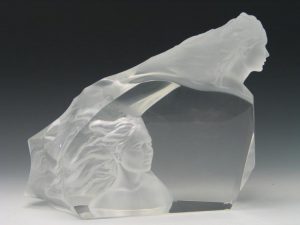ABOUT THE ARTIST
Frederick Hart (1943-1999) is recognized worldwide as the most prominent figurative sculptor of the last century.
Beginning his life in Atlanta, and his career in Washington, D.C., Hart was the epitome of the starving artist. He saw that he was spiritually descended by famed figurative masters such as August St. Gaudens and Daniel Chester French, but he failed to realize the fame these artists enjoyed. He toted around Dupont Circle, sculpting girlfriends, kids and buddies but not truly finding his calling. He became despondent with the lack of skill on the “modern” art scene, and more the notion that we had forgotten what it meant for something to be beautiful, timeless and everlasting.
He then discovered the Washington National Cathedral, the seventh largest cathedral in the world, and the only place he could truly surround himself with the Italian master stone carvers who would make him the master. he carried tools, fetched coffee and finally ingratiated himself into the cadre of stone carvers, whose impermeable ranks were so hard to breach. the headmaster himself, Roger Morigi, a temperamental Italian, with a penchant for the “tough-love” way of teaching, took him as an apprentice.
In 1971, Hart heard of the competition for the commission of the sculpture to adorn the west facade of the Cathedral. For the next three years he worked in his own unheated studio, “almost starving to death” as he sketched his ideas for the Cathedral’s international competition. Hart remembered “It was to be a contemporary idea of Creation, a vision of an unfolding universe.” Inspired by Pierre Tellhard de Chardin’s writings on science and theology, hart envisioned a great allegorical work which would evoke the heroic struggle for awakening and consciousness. the selection committee was impressed with the power and became the most prominent religious sculpture of our day. “Ex Nihilo” (Out of Nothing), an eight figure, larger than life, swirling mass, which notoriously gained recognition as the subject of the lawsuit against the makers of the movie “The Devil’s Advocate”, which Hart won. The sculpture was thirteen years in stone carving, and finally dedicated in 1982. Hart created six major sculptures giving him a similar historical place among masters such as Bernini, Michelangelo and Rodin. Hart said, upon it’s completion “my life’s work is complete, my density fulfilled.”
Once complete Hart looked through the art journals and literary magazines for some mention of this masterwork, and none came. Hart hoped he would find an article panning it, just to let him know that someone was watching figurative work. No one was. hart’s sculpture was ignored because it was in the tradition of the old school, and therefore offered no new ideas.
During this cycle, Hart heard about a commission to be awarded for the dedication of a new “Vietnam Veterans Memorial” to be placed on the Mall if front of the Washington Monument. The requisite element was that all 58,000 dead must be named. Hart entered a sculpture containing both a wall with the listed dead, as well as a medic running toward a wounded solider. the board voting on the monument awarded the commission to a 21-year-old Yale University architecture student, Maya Ying Lin. Lin’s design was a minimalist black granite wall, shiny, deeply cut into the Earth. This set off a series of bitter debates that occupied the United states for some time. The problem that veterans (and Hart) had with it, was that it lacked a human face. How would such a wall translate to a society one hundred years from now? Once we are dead and gone, would it still have any impact, like the sculptures of civil war heroes? Vets called it the “great black gash of shame and sorrow.” Hart simply called it “a telephone book listing of dead people.” Funding for the project was withheld until a suitable solution could be reached. The idea was proposed that a figurative element be placed near the monument, at its apex. Hart was given the commission, and altered the plan. Instead of placing his “Three Servicemen” at the apex, he placed them approximately 400 feet from the wall; looking, as one Vet said “for their own names.” this satiated both sides and quelled the debate. Hart mentioned that the monument was one of the hardest places for him to visit, because after absorbing all of the interviews with GI’s, and the controversy surrounding the monument itself, he had to synthesize it into what it became, in his words “the most effective ensemble monument in the United States.” This monument has become the most visited in Washington, D.C. and the “Three Servicemen” are some of the most recognized faces in modern sculpture. Yet, when Hart checked those same sculpture journals and literary magazines, no mention was made of these overtly sentimental, hero figures. Only the genius of the minimalist wall. Hart was despondent, but not done.
The statue of Three Soldiers which he created for the Vietnam Veterans Memorial in the nation’s capitol has in hart’s words, “a wholly unnerving, enigmatic, existential quality which I think is very appropriate for the Vietnam War.” The fighting men portray the veterans’ bond of love and sacrifice and mutual devotion as they stare at the wall, almost as if they are searching for their own names. The artist expresses the concept behind his design: “I see the wall as a kind of ocean, a sea of sacrifice that is overwhelming and nearly incomprehensible in its sweep of name . . . I place these figures upon the shore of that sea, gazing upon it, standing vigil before it, reflecting the human face of it, the human heart.: Cast in bronze, this historic sculpture – now one of America’s most famous sculptures – was dedicated in November, 1984, at a major ceremony attended by President Ronald Reagan and more than 100,000 veterans.
In the early 70’s, after sculpting in stone (the stone age) and bronze (the bronze age), Hart turned his attention to Light. He believed we were entering an age of enlightenment, “The age of Light.” So he began developing the uses of clear acrylic resin, to “Sculpt in light.” Harking back to the teachings of Chardin, and his vision of creation, Hart created a new legacy with his developement of acrylic as a figurative media. The Children of Ex Nihilo were born. After releasing his first sculpture in the “Age of Light” collection, in 1984, Hart’s vision became clearer and he began to realize the artistic and commercial success of his work. Subsequent works experimented with imbedding one acrylic sculpture within another, which Hart patented. The mystery of this technique still confounds viewers and technicians to this day. Through commercial success and public monuments, works for Pope John Paul II such as “Cross of the Millennium,” Hart still surprisingly enjoyed little critical acclaim.
On August 13, 1999 at the age of 55, Hart died of lung cancer which was diagnosed only two days before. His career, now having a finite beginning and a finite end is looked upon in retrospect, not as single works, but as a body of work; a total idea. What we are finding is that Hart changed our “zeitgeist,” (spirit of the age) from one that vilified beauty, into one that embraced the things that are beautiful in life. As a member of the “Centrists,” a group of poets, theologians, musicians, artists and those dedicated to making us rethink the beautiful, Hart brought us back to the lost items of our existence. “The abiliry to have faith; to sustain hope; to feel the transforming power of beauty; and to revel in the innocence of the world around us.”
An article included in the “New York Times: magazine at the beginning of 2000 went miles in explaining who this artist was, what he offered to us and what he left us. Of all the articles written about Hart posthumously, none had more of an effect on people than this one. Translated into over thirty languages and reprinted worldwide, the article brought Hart the recognition that he always relished. The author of the article was Tom Wolfe, author of “A Man in Full.” He explained to people what it was to be an ignored master, and what it meant to be a humble servant of the cause, one of beauty and timelessness.
“I believe that art has a moral responsibility, that it must pursue something higher than common man. It must be an enriching, ennobling and vital partner in the public pursuit of civilization. It should be a majestic presence in everyday life just as it wasin the past.” These are the words of Frederick Hart who has been described as one of America’s greatest representational artists. He has gone completely against the grain of the contemporary art world; substance and beauty are the chief criteria of his work. “My work isn’t art for art’s sake, it’s about life. I have no patience with obscure or unintelligible art – I want to be understood.”

